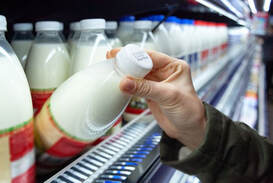… from the Perspectives’ Kitchen  How you doin’? I don’t know about you, but I hate to throw away food. Throwing away good food is sinful! So, how can you avoid wasting food and money? It starts by buying right. While it’s tempting to see all that is being offered in today’s supermarkets it is important to only buy what you can eat within a short period of time. Personally, I’m a weekly shopper with very little mid-week fill-in shopping. During the summer, the produce department looks so tempting that you want to buy everything especially in the fresh-cut departments; these items have a really limited shelf life. Always check the label on when ready-mixed salad greens were harvested and when fresh cut fruits and vegetables were prepared and packaged. The same goes for groceries from the center of the store. Because of the different nomenclature used, food labeling can be confusing. A survey from the National Resources Defense Council found that nearly 90 percent of Americans toss out food prematurely. Much of this waste can be attributed to a confusing food dating system that is not federally regulated. Here's what you need to know to get the most out of groceries and avoid expensive toss outs. The FDA states on its website that, except for infant formula (assuming you can find any), product dating is not required by Federal regulation. The food dates or "expiration dates" we're so familiar with are not necessarily indicators of food safety at all, they are simply the manufacturer's suggestion as to when their product is at the best quality. So, what does this mean for you the consumer? You may very well be throwing out food while it's still perfectly safe to eat. The best way to combat this waste is to be familiar with common food labels and their meanings. Let me break down the meaning behind these food labels and give a general guideline as to how long groceries will last. What Do Common Date Labels Actually Mean? I've already established that food labels generally refer to quality, not food safety. This begs the question, what are our food labels telling us about the quality of our food? And what's the difference between sell by, use by, best by, and all the other labels? Let me break it down here: Sell By The sell-by date simply tells retailers how long to display the product before taking it off the shelves. It's in no way an indication of safety. Grocery stores will often try to get rid of older inventory through sales, but it is still safe to eat! Best If Used By/Before The most heeded food date is the best-by date, but the label is a little misleading. As with other food dates, this label doesn't indicate when a product is "best" in terms of safety, but rather in terms of quality. So, the best-by date simply refers to when a product will be at its flavor or quality peak. Guaranteed Fresh This date usually refers to bakery items. It simply indicates when the item will be at peak freshness, but it's still safe to eat after this date. Out-of-code breads are still tasty when slathered with butter and garlic and toasted to perfection. Use By This refers to the last date recommended by the manufacturer for use of the produce while at peak quality. The only time this refers to safety is in the case of infant formula. Pack Date The pack date is the code that refers to the date the food was washed, graded, and packaged. This is commonly found on egg cartons. The tricky thing with this label is it's not the easiest to read. The label is often in a code that represents the day of the year that it was packed. For example, 001-22 would refer to January 1, 2022, and 365--22 would refer to December 31, 2022. Sometimes the code also includes a number representing the production facility, and sometime also includes the shift number or actual time produced. Freeze By This date indicates when a product should be frozen to maintain peak quality as long as it's frozen. Some labels even read consume by or freeze to maintain quality. How to Know If Food Has Gone Bad Let me share some “general” guidelines as to how long different types of foods are safe to eat—keyword here being general. What's most important to know about food safety are the signs of spoilage.
How Long Are Foods Safe to Eat? General Food Guidelines The food storage guidelines come from the USDA Food Safety and Inspection Service: Refrigerated Foods (these guidelines assume your refrigerator is holding temperature at or below 40°F, ideally about 36⁰ F).
How to Stretch Food Past Its Expiration Date If food can’t be cooked and it is on the verge of going bad, there are several ways you can stretch it well past the expiration date. Refer to my guide on how to safely freeze, thaw and reheat food. Make the most of seasonal produce canning fresh fruits and veggies for enjoyment well into the winter months. Even with these preserving methods, the food will only be as fresh as it was at the time it was stored. Keep food from spoiling before you have a chance to freeze or can it, by keeping it out of the "temperature danger zone," as much as possible. This is the range we call the kill zone—41⁰ F to 140⁰ F—in which bacteria grows the most rapidly. I keep my refrigerator temperature at 36⁰ F. I keep my freezer at below 20⁰ F. Food Safety Guidelines HYGIENE: Wash and Sanitize Hands--Before working with food and after eating, using the toilet, or covering a cough or a sneeze and after using the telephone. HOLDING: Hot Foods Above 145° F; Cold Foods Below 40° F. TEMPERATURE: Sanitize thermometer between tests. RE‑HEATING / COOLING: Re‑Heat Foods To 165° on stove, in the microwave or in the oven. Rapidly cool large amounts of food in shallow pans in the refrigerator or freezer. FOOD HANDLING: Do Not Serve any food that has been placed on unclean work surfaces or foods held at unsafe temperatures. FOOD STORAGE: Label foods not stored in original containers. Do not store foods on the floor. Date & Rotate all foods--First In, First Out. CONTAMINATION: Clean & Sanitize All Utensils & Tools From One Food Product To Another. Never mix cooked and uncooked food in the same area. Keep poultry separate from other foods. Use the sink to wash, rinse, sanitize. ILLNESS / INFECTION: Do Not Handle food when sick, with open cuts or sores or with an infection. MAINTENANCE: Keep all cleaning equipment in Good working order. Check detergent and sanitizer levels. CHEMICAL STORAGE: Label and store cleaning supplies and pesticides Away From Food. INSECTS/RODENTS: Store trash in covered, lined containers. Keep Refuse Area Clean and away from fresh food. Seal wall openings and keep doors in good repair. ChefSecret: More food borne illness cases originate in peoples’ home than in restaurants. Yes, that turkey that sat out for 2 or 3 hours at Thanksgiving may not be safe to use for leftovers. Quip of the Day: What do you call a plate of spoiled sausages? A bunch of brats. (Get it? Brats? HA!) ------------------------------------------- Do you have a question or comment? Send your thoughts to [email protected]. All recipes and cooking tips are posted on our website https://www.perspectives-la.com/covid-19-survival-guide. ------------------------------------------- To you and everyone dear to you, be strong, be positive, stay well, stay safe and be kind. Take a breath and count your blessings, and if you have a little extra to share with others, please consider donating to Feeding America. #SpecialEdition #ExpiredFood #FoodSafety #FDA #BestBy #UseBy #Fresh #USDA #SpoiledFood #Covid19SurvivalBlog #FeedingAmerica #PerspectivesTheConsultingGroup ©Perspectives/The Consulting Group, LLC, 2022
0 Comments
Your comment will be posted after it is approved.
Leave a Reply. |
For over 4 decades collaboration and vision have been the cornerstones of our approach to developing innovative solutions. We fuel innovation, uncover opportunities, discover trends and embrace sustainability, turning imaginative ideas into profitable realities. Categories
All
Archives
July 2024
|
www.perspectives-la.com
Copyright © 2021 Perspectives/The Consulting Group, LLC | Henderson, NV 89052 | 310-477-8877
Copyright © 2021 Perspectives/The Consulting Group, LLC | Henderson, NV 89052 | 310-477-8877


 RSS Feed
RSS Feed